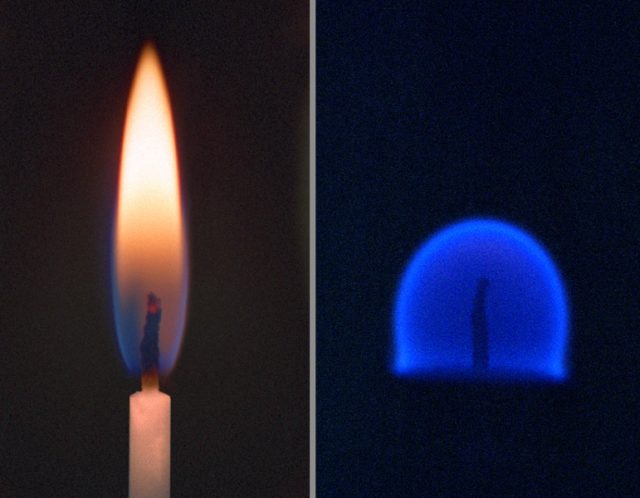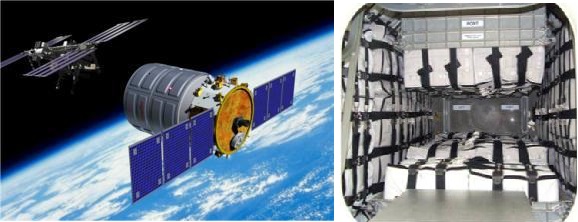Dealing with fire in microgravity
All we know about fire under Earth´s gravity must be questioned in microgravity. In fact, most of the well-known characteristics of fire behavior are driven by the effects of gravity. That´s why the science of combustion in low-gravity environments is an important field of knowledge for NASA studies when evaluating spacecraft safety. And, contrary to what one might think, this field of knowledge is quite unexplored yet. Most of the technology and standards used for fire prevention, detection and suppression in spacecraft have been developed for terrestrial purposes under normal gravity conditions 1, and yet, the absence of gravity has unexpected consequences which cannot be just extrapolated from our experience on Earth.
This is not a minor issue for manned space shuttles, as they present a high risk of fire per se. To begin with, they are confined volumes where firefighting and rescuing are really challenging. So does the possibility of evacuation of toxic particles coming both from the by-products of the combustion or from extinguishers. Moreover, spacecraft come with a large number of circuit boards and electrical cabling, usually enclosed behind walls with a high risk of overload and difficult access, making the detection of the ignition source equally hard. One might think that using non-flammable materials eliminates the risk of propagation in the event of a fire, and then solve the problem once and for all. But this is not an option at a time when the use of polymeric materials is so widespread. Polymers have become the most versatile kind of materials, which can be tailored to fit almost into every sort of function; they are priceless in aerospace, saving cost and weight while maintaining good mechanical properties. However, these advantages come also with some drawbacks, one of them being the high flammability risk they bring into any practical application. As a result, tackling fire safety in spacecrafts entails not only material control but also good knowledge of fire behavior of these materials and how to handle fire hazards once the combustion has started.

Three components are needed to initiate a fire: the fuel, typically a flammable material as could be the plastic present in electrical cables, oxygen, and an ignition source, which will provide the heat required to start the thermal degradation of the fuel material. This thermal degradation, which is basically the combustion process, breaks down big molecules of the polymeric material into smaller volatile species that abandon the condensed phase (the molten polymer) to become part of the gas phase, which we usually recognize as the fire itself. Once these volatile species integrate into the gas phase, they are subjected to convection currents that lead hot, low-density gases upwards, and replace them with cool, high-density air. That’s gravity in action. The typical long, thin shape of a flame, as seen on the left image in the figure above, is the direct result of gravity exerting its force over the products of the combustion process.
This specific characteristic of buoyancy of the combustion products taking over the development of a fire is crucial in further actions to prevent and suppress fire hazards. Many usual parameters used in fire testing of materials, such as flame spread rate, heat release rate, residence time of toxic species in the surrounding area, or the oxygen level needed to sustain the flame (to name a few of the most relevant ones), have been chosen under the assumption that the products of the combustion are subjected to Earth´s gravity effects. The same is true for some of the most common strategies used by fire retardant compounds to achieve the inhibition, delay, or suppression of the combustion process. One of these strategies, for instance, involves adding compounds to the polymer matrix that reduce the viscosity of the condensed phase (the polymer melt) during the combustion process, driving the polymer flow away from the ignition source and then avoiding it to keep feeding the flame. This effect is called dripping, and it is highly dependent on gravity acting over the polymer melt. Even smoke detectors work under the assumption that the toxic particles coming from the combustion process will eventually reach the detector, usually located somewhere in the ceiling of the cabin, due to buoyancy of the hot gases coming from the fire area.
But the fact is, this upward flow of hot gases so common from our experience on Earth is nearly non-existent in microgravity, where there aren’t natural convection currents. As a result, the lack of buoyancy prevents hot gases from abandon the combustion area, then rapidly overheating the fuel material. The immediate consequences of this overheating effect make a big difference in fires taking place in microgravity2. Firstly, the initial stage of the fire, that is, the ignition, is most likely to happen in thermally stressed parts, such as the above-mentioned electrical cabling. The reduced heat transfer in the surrounding area prevents the ventilation effect that would be common on Earth, leading to ignition occurring at lower temperatures and heat energy values. Secondly, the combustion products persist in the area for long times, making them harder to detect, slowing down the flame propagation, and feeding back the thermal degradation taking place in the condensed phase of the fuel material. The persistence of the combustion by-products in the surroundings of the fire defines the characteristic, symmetrical shape of the flame that can be observed in the right-hand image in the figure above.
Fire behavior differs so much depending on whether it takes place under Earth’s gravity or in microgravity that is quite surprising that spacecraft fire safety is provided by systems specifically designed for terrestrial purposes. That’s why an international group of fire researchers, including NASA but also different universities and institutions from France, Germany, UK, Russia and other countries, have undertaken the task of studying the patterns of fire ignition and propagation under microgravity conditions in spacecraft environment3. The research project is called Spacecraft Fire Experiments (Saffire) and Cygnus is the shuttle designed to carry out the ongoing large-scale fire testing program.

This comprehensive study will establish the grounds for a novel low-gravity combustion science which not only will account for the fire behavior of materials in microgravity, but also will explore the effects of different gravity values, such as those in the Moon or Mars, allowing the development of new models for fire growth under different conditions of buoyancy, convective heat transfer and diffusion. The results of the study will also help to create new strategies for the development of fire resistant materials, as well as new techniques and standards to account for the specific flammability requirements to meet in space shuttles. A whole and fascinating new field ready to be explored.
References
- Olson S. L., Ruff G. A., Microgravity flame spread in exploration atmospheres: pressure, oxygen, and velocity effects on opposed and concurrent flame spread, NASA/TM-2008-215260. Glenn Research Center (USA) ↩
- Ruff G. A., Microgravity research in spacecraft fire safety, Halon Options Technical Working Conference, 2001. NASA Glenn Research Center (USA) ↩
- Eigenbrod C. et al, Fire safety in space – beyond flammability testing of small samples, Acta Astronautica 109 (2015). ↩
1 comment
[…] por noesbasura | Feb 15, 2016 | Chemistry, Noticias, Physics, Science, Technology | 0 […]